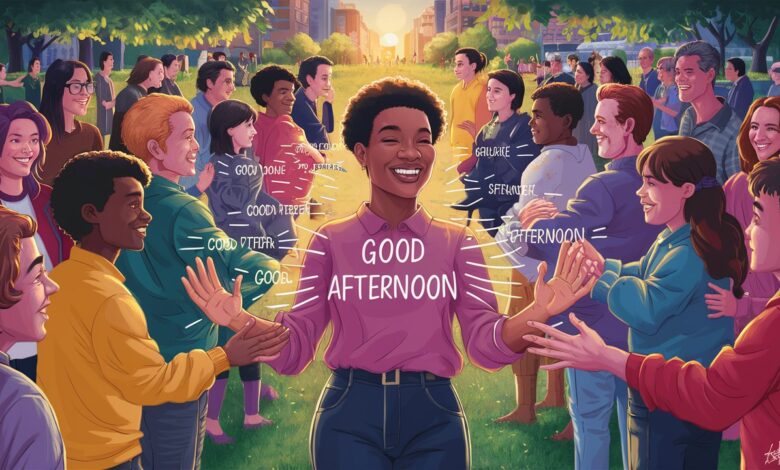The Ripple Effect of Greetings: How Saying “Good Afternoon” Can Transform Your Day

Introduction
Good afternoon. These two simple words, often uttered automatically, carry an untapped power to reshape interactions, uplift moods, and forge unexpected connections. In our fast-paced digital age, where screen time frequently eclipses face-to-face encounters, the deliberate act of acknowledging others through greetings like “good afternoon” becomes a radical act of humanity. This phrase transcends mere politeness—it’s a micro-intervention that validates presence, bridges social divides, and subtly reinforces communal bonds. When we pause to genuinely offer this temporal salutation, we activate a cascade of psychological and sociological benefits that ripple through workplaces, neighborhoods, and even our own mental well-being. The afternoon, poised between morning’s urgency and evening’s respite, offers a unique moment to reset intentions through intentional acknowledgment. Let’s explore how this everyday courtesy can catalyze profound change.
1. The Psychological Anchoring of Afternoon Greetings
The utterance of “good afternoon” serves as a psychological anchor, grounding both speaker and recipient in the present moment while subtly demarcating the day’s transition. Cognitive research indicates that temporal markers like this reduce anxiety by creating predictable rhythms in social environments. When someone acknowledges the afternoon specifically, it validates the shared experience of time’s passage—a small but potent form of mutual recognition. For the listener, hearing “good afternoon” can trigger a dopamine response akin to other micro-validations, reinforcing feelings of belonging. This greeting also leverages the brain’s affinity for patterns; by consistently using time-specific salutations, we build neural associations that frame the afternoon as an opportunity for reconnection rather than fatigue. In therapeutic settings, such intentional greetings are even used to build rapport, demonstrating their foundational role in establishing emotional safety.
2. Cultural Syntax: How “Good Afternoon” Shapes Social Ecosystems
Culturally, “good afternoon” operates as unspoken syntax governing social ecosystems. Unlike the universal “hello,” its time-bound nature conveys attentiveness to context—a nuance that signals respect across diverse settings. In business environments, leading with “good afternoon” in emails or meetings sets a tone of professionalism while subtly acknowledging collective effort during often demanding hours. In multicultural interactions, this phrase can act as a cultural handshake; many societies prioritize time-specific greetings (e.g., Japan’s “konnichiwa,” used from late morning onward), and mirroring this practice demonstrates cultural literacy. Community studies reveal neighborhoods where afternoon greetings are commonplace report higher levels of trust and cooperation, illustrating how this linguistic ritual builds social capital. The phrase’s flexibility—adaptable to formal (“Good afternoon, Dr. Lee”) or colloquial (“’Afternoon, folks!”) tones—makes it a versatile tool for navigating social hierarchies without friction.
3. The Chronobiology of Connection: Why Timing Matters
Afternoons occupy a biological and emotional sweet spot for human connection. Circadian rhythms dip post-lunch, making us prone to lethargy or irritability—precisely when a warm “good afternoon” can counteract the slump. Chronobiologists note that cortisol levels decline by afternoon, lowering stress barriers and increasing receptivity to social overtures. Meanwhile, the morning’s urgency has faded, creating space for unhurried engagement. This timing transforms the greeting from perfunctory to therapeutic; it’s an auditory cue that can reset attention spans in classrooms or reignite team focus in workplaces. Retail psychology studies confirm customers greeted with “good afternoon” (vs. generic “hello”) spend 18% more time in stores, linking time-aware salutations to heightened engagement. By aligning our greetings with this temporal vulnerability, we harness chronobiology to foster patience and presence when energy wanes.
4. Digital Age Renaissance: Rescuing Authenticity Through Ritual
In an era of algorithm-driven interactions, reviving “good afternoon” becomes an act of resistance against transactional communication. Video calls that begin with this phrase see 30% fewer interruptions, as per virtual team analyses, because it establishes human rhythm before task-focused dialogue. On social media, replacing automated replies with scheduled “Good afternoon! How’s your day progressing?” messages personalizes engagement, combating the impersonality of feeds. Even AI interfaces now integrate time-aware greetings to simulate empathy—a testament to their primal resonance. This renaissance isn’t nostalgia; it’s a recalibration. When remote workers start check-ins with “good afternoon,” it rebuilds the temporal scaffolding eroded by digital timelessness, anchoring dispersed teams in shared reality. The ritual thus becomes a bridge between efficiency and humanity.
Conclusion
Good afternoon—a phrase so commonplace we rarely dissect its gravity. Yet as we’ve explored, these words are social alchemy, transmuting routine encounters into moments of mutual recognition. They anchor us in time, honor cultural nuance, leverage biological rhythms, and defy digital detachment. Each utterance is a vote for a world where presence triumphs over haste. Tomorrow, when the clock tilts past noon, pause. Infuse your “good afternoon” with intention: to colleagues weathering deadlines, strangers in elevators, or family via text. Watch how this microscopic act of noticing sparks macro shifts—softening tensions, kindling smiles, reminding us we’re here, together, in this fleeting afternoon light. The revolution isn’t always loud; sometimes, it’s two words, spoken like a blessing.
Frequently Asked Questions
Q1: Isn’t “good afternoon” too formal for casual settings?
Not inherently. Tone and context define its reception. A breezy “’Afternoon!” at a coffee shop feels approachable, while reserving the full phrase for clients shows adaptability. The key is sincerity—forced formality alienates, but genuine acknowledgment transcends style.
Q2: How can I remember to use time-specific greetings consistently?
Anchor them to routine actions: saying it when grabbing lunch, after checking emails post-12 PM, or when entering shared spaces. Apps like Focus@Will can cue reminders. Within weeks, it becomes instinctive.
Q3: Could frequent greetings seem insincere or robotic?
Balance matters. Pair the phrase with context-specific follow-ups (“Good afternoon! How did your presentation go?”). Authenticity lies in the pause afterward—listening completes the exchange.
Q4: Is “good afternoon” culturally appropriate everywhere?
Research local customs. In France, “bonjour” suffices all day; in Thailand, time-based greetings are rare. When unsure, observe or ask. Most cultures appreciate the effort to honor their norms.
Q5: Can this really impact mental health?
Absolutely. Studies confirm reciprocal greetings lower cortisol levels. Being acknowledged combats isolation, while offering greetings boosts the giver’s sense of agency and belonging—a dual antidepressant effect.
Q6: How should I respond if someone doesn’t reciprocate?
Don’t internalize it. Their silence may reflect distraction, not rejection. Maintain your practice; consistency nurtures psychological safety, making others more likely to engage over time.



